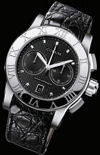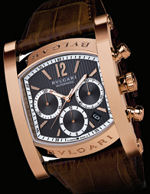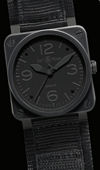Individualist Chic
May 31, 08

Experts on the crème de la crème brands, London-based Ledbury Research claim that an increasingly important motivator for buying beautiful objects is the joy of owning something others have never seen before.
In the watch world today, we are witnessing a move towards the cachet of uniqueness – or at least the perception of it.
The most obvious manifestation of this trend is the slew of limited edition watches that have come onto the market in recent years. Almost every major brand brings out limited edition watches, while a few claim all their watches are limited in number. These timepieces play to a luxury consumer’s desire for something unique, sought after and collectible. Even if some of these watches are made in surprisingly considerable numbers, the emphasis is far less on brandishing logos than on appropriating and investing in a rare find.
At the same time, a fresh crop of avant-garde, independent watchmaking talent is daring to imagine the future of watch design. All produce in small numbers on largely ideological grounds. While lovers of luxury seek individuality, the work of small watchmakers could now prove to be more timely than ever.
Watchmakers such as these embrace the notion of appealing to the minority of people who treasure their watches almost as they would art. Take English watchmaker Roger Smith – he will make ten watches in 2008. Max Busser & Friends will make 250 Horological Machine No 2 watches over the next three years.
At this year’s BaselWorld, more than 30 independent and idealistic watchmakers exhibited together under the banner of the AHCI (Horological Academy of Independent Creators). Founders of the collective, Svend Andersen and Vincent Calabrese came together in the 1980s with the idea that small independents would join forces for marketing purposes to enable them to each express their individuality and create watches that are works of art. The atmosphere at this section of the fair is always far less frenetic than other halls and hugely inspiring to some.

“Seeing watchmakers like Vincent Calabrese, Svend Andersen and Vianney Halter and watch forum commentator Dr. Bernard Cheong just standing around was like walking into a Hollywood studio seeing Steven Spielberg right there and happy to chat,” recalls London-based watch addict Alex Coutts, a regular on watch forums Horomundi and Watchprosite, who visited Hall 5 last year and drooled. He calls Philippe Dufour “almost like God” when it comes to watchmaking. “Dufour produces watches of unsurpassable quality,” he says.
Meanwhile, even the huge luxury goods brand Montblanc is recognizing growing interest in high-level watchmaking in small numbers. Its Villeret manufacturer trains its watchmakers in-house for two to three years after they’ve completed watchmaking school. “The inside of each barrel is decorated by hand on its hidden parts. Only a watchmaker who repairs the watch will ever see this,” explains Alexander Schmiedt, Villeret’s business director.
Anglo Swiss duo Greubel Forsey are making improvements to timekeeping with the tourbillon – a complication originally found in pocket watches, which counteracts the inaccuracies caused by gravity – that have barely been attempted in over a century.
Output from small manufactures such as these is truly limited because producing more watches is simply not economically viable.
Busser, formerly head of Harry Winston Rare Timepieces and previously at Jaeger le Coultre, has now consciously turned his back on the big brands and is determined to create novel watches only a few will love. “We are not aiming to please the majority at MB+F. We are putting our guts into our work without any commercial considerations. We don’t follow any brand DNA – we believe that’s true art,” he says.
So, what initially prompted the boom in the notion of the limited edition? The first modern limited edition to kick off the trend was the Patek Philippe 150th anniversary model , launched just prior to the 1989 anniversary auction, according to Charles Tearle, Bonhams’ Los Angeles based watch expert. Based on a 1920s design in yellow gold, 2000 models retailed for £5000 ($8,200 based on an average exchange rate of $1.64 to the pound) each and were soon re-selling for up to £20,000 ($32,800).
Given the potential for price appreciation over time, the notion of the limited edition became extremely attractive. In 2000, Patek Philippe created a ten-day wristwatch to celebrate the millennium. The movement had never been used in any watch beforehand and Philippe Stern, CEO of Patek Philippe, confirmed in a certificate that the tools used to make the watch were destroyed to ensure they would never be used again. According to Aurel Bacs, Christie’s Geneva based watch expert, these watches now fetch between double and triple their retail value at auction. A platinum version originally retailed at £15,000 ($22,755). In the last year, one of these sold for £80,000 (approximately $160,000). (Platinum is rarest so appreciation for these is steepest.)
|
|
Meanwhile, some companies commit to producing in small numbers. Most watches made by Piaget, like its Altiplano 38mm in platinum, are available in a maximum of 50 pieces. Graham, who generally produces up to 250 watches for a limited edition watch, has brought out the Graham King George limited to just ten pieces. Watchmaker and minute repeater specialist Christophe Claret admits this grande complication is the most complex watch he has ever put his hands to.
There is something authentic and idealistic about this niche approach, and it adds to the appeal of this kind of watch. Most minute repeaters and other hyper technical watches such as Jaeger le Coultre’s Extreme Lab and SkyMoon tourbillon or Harry Winston’s Glissère also fall into this category.
New limited editions abound in 2008. Bell & Ross’s latest watch to allude to a plane’s clock and claiming to “take its inspiration from stealth bombers” is the BR01 Instrument Phantom, a monster of a watch, available for 500 fearless owners. Chaumet’s Dandy Jumping Hour watches are each numbered and limited to 100 pieces. Each Talisman 8 Watch from De Beers, gorgeously encrusted with rough diamonds, is a numbered edition.
Ebel’s new association with football has resulted in the Ebel Bayern Munich incorporating a movement specially designed for the game, the Calibre 245 – alluding to the two half times of a game of 45 minutes, available in 300 pieces.
Richard Mille, who aims to be for watches what Maclaren is for racing cars, generally produces around 900 watches annually. He has recently teamed up with Boucheron on 30 watches with different precious stone combinations, some found on the wheels of the movement.
There is in fact some irony associated with the limited edition. In some cases, watches marketed as limited editions are actually available in considerable numbers.
“I think the limited edition has been done to death,” says Bond Street’s frankest watch man, the ebullient Marcus Margulies, owner of the Marcus watch store and Time Products, which distributes Audemars Piguet, Hublot, Urwerk, Greubel Forsey and Hautlence in the UK. “It’s an overplayed gimmick and it’s become a bog standard thing. I don’t see how a watch is limited edition if there are 1000.”
Nevertheless, limited editions available in the thousands abound and continue to generate considerable interest amongst enthusiasts. All IWC’s limited edition watches, including the 2500 stainless steel Pilot’s Chrono Automatic Edition Laureus Sport for Good Foundation watches have been sold. Launching at BaselWorld, Tag Heuer’s newest Carrera Calibre 1 Vintage watches are a limited edition of 6000.
|
|
In recent years, an increasing number of big name watchmakers from Zenith, to Jaeger le Coultre, Maurice Lacroix and Panerai have begun to emphasize and trade on their manufacture credentials, priding themselves on making al l of the components of their watches in-house. The magic of the manufacture – where your watch is painstakingly handmade from start to finish under one roof the old fashioned way (even if the brand is owned by a huge conglomerate of luxury brands) – is gaining ground. In this climate, independent watchmakers are bound to offer an alternative and sometimes more niche appeal for the watch lover or connoisseur.
While a flow of limited edition watches carry the suggestion that they will retain value over time, consumers are enjoying a huge choice of watches their peers are unlikely to have seen before. Meanwhile, an interest in individualistic watches shows no sign of abating.
“There are definitely more people now on watch forums who are buying independent watches for the first time. Word is travelling and clearly there are others who are not on the forums. But if too many people find out about them, they might lose their romance,” says Baruch Coutts.

